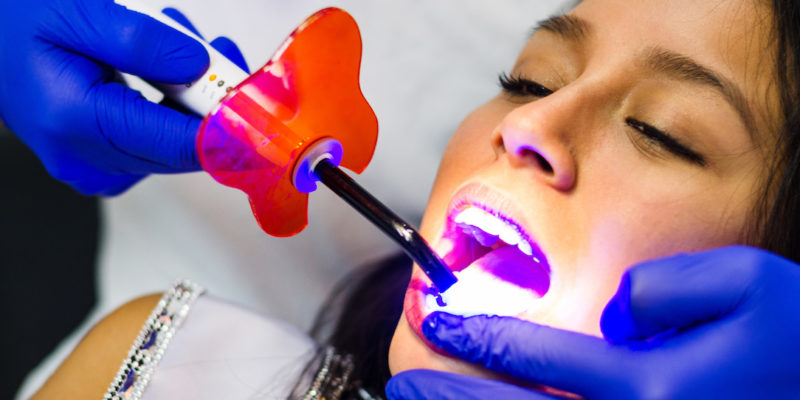How Dental Lasers Can Make Treatments Safer and More Bearable

You brush and floss everyday, but is that enough? Unfortunately, solely brushing and flossing isn’t going to get your mouth as clean as it needs to be. A major advancement in the dental field is the use of dental lasers. Lasers have found itself to be a technique in dentistry that improves results, and makes treatments more comfortable for the patient. Did we mention it can also make the procedures safer? It has all kinds of benefits! So, how does a laser work and what is it used for? Let’s go over it.
What Are Lasers and How Do They Work?
Lasers in dentistry have been around since the mid ‘90s to treat various dental problems. Lasers deliver energy by using light. WebMD states that when lasers are used in surgical or dental procedures, it acts as a cutting instrument or a vaporizer of the tissue that it comes in contact with. However, when a laser is used in teeth-whitening procedures, it acts like a heat source and enhances the effects of the bleaching agents.
Laser Teeth Cleaning
Brushing and flossing are a major part of cavity prevention, but cleaning the surfaces of your teeth is only one piece of what helps keep your mouth as clean as it needs to be, which is one reason why it’s important to see your dentist 2x a year for optimal health!
Traditional teeth cleanings use scalers and other metal tools to remove plaque and tartar stuck on the teeth. More modern though is the use of dental lasers for cleanings. Using a laser for a cleaning also helps remove buildup on the patient’s teeth and gums. Lasers also provide a more in-depth cleaning, since they can be used on soft tissue, like the gums, as where metal tools can’t be.
Not only can lasers get you that deep clean mouth you’re wanting, but they can also help in a number of different dental office procedures.
Lasers vs. Dental Drills
If you compare the laser to dental drills, you’ll see that lasers do have some benefits, like:
- Causing less pain which reduces need for anesthesia
- Reduces anxiety in patients who are frightened by thought of using drill
- Lowers bleeding and swelling risk during work done on the soft tissues of the mouth
- Can help maintain more healthy tooth during the removal of cavities
Types of Lasers
Lasers are still not considered a mainstream technique within the field of dentistry, but there are several different types of lasers on the market that dentists use everyday. Colgate breaks the types of lasers down by soft tissue vs. hard tissue lasers.
Soft Tissue Lasers
Most commonly lasers are used in procedures that affect gums and the other soft tissues of the mouth. Lasers have the capability of cutting soft tissue which makes them useful in procedures where dentists need to manipulate the gums.
Dr. Ania often uses dental lasers in her practice to provide a speedy and less painful treatment for certain procedures, and for treatment that may not have been possible in the past.
Hard Tissue Lasers
These lasers work on the teeth. Hard tissue lasers are able to remove tooth decay, prepare cavities for filling, and even prepare tooth for a root canal. Lasers for hard tissue procedures can minimize the need for sedation, but it can also result in longer treatment time.
What Can Dental Lasers Treat?
Dr. Ania can use dental lasers to treat cold sores with low intensity dental lasers that reduce irritation and minimize healing time. These lasers are also used to detect and treat cavities, enhance a smile by reshaping the patients gums, eliminate benign tumors, whiten teeth and more. Other uses of the laser in dentistry include:
- Deep cleaning of gingival pockets
- Removal of diseased tissue
- Sterilization of root canals
- Reshaping the gums
- Dental implant exposure
- Teeth whitening
What Can’t Dental Lasers Do?
There is no cure-all for anything, and unfortunately there are some things that lasers can’t help with. These include:
- Teeth that already have fillings
- Common dental procedures like cavity fillings located between teeth or those that need a crown.
- Lasers can’t remove crowns or silver fillings
- Lasers may not fully remove the patient’s need for anesthesia
In addition, laser treatments can be more pricey when compared to the traditional dental drill.
Elevate Your Cleanings With Dr. Ania
Overall, the benefits of laser dentistry over handheld tools include precision, less pain, quick healing, and minimal bleeding and swelling. If you’re ready to elevate your trip to the dentist, schedule an appointment with Dr. Ania today to see just what lasers an do for you. Call us – (303)-872-9940.


